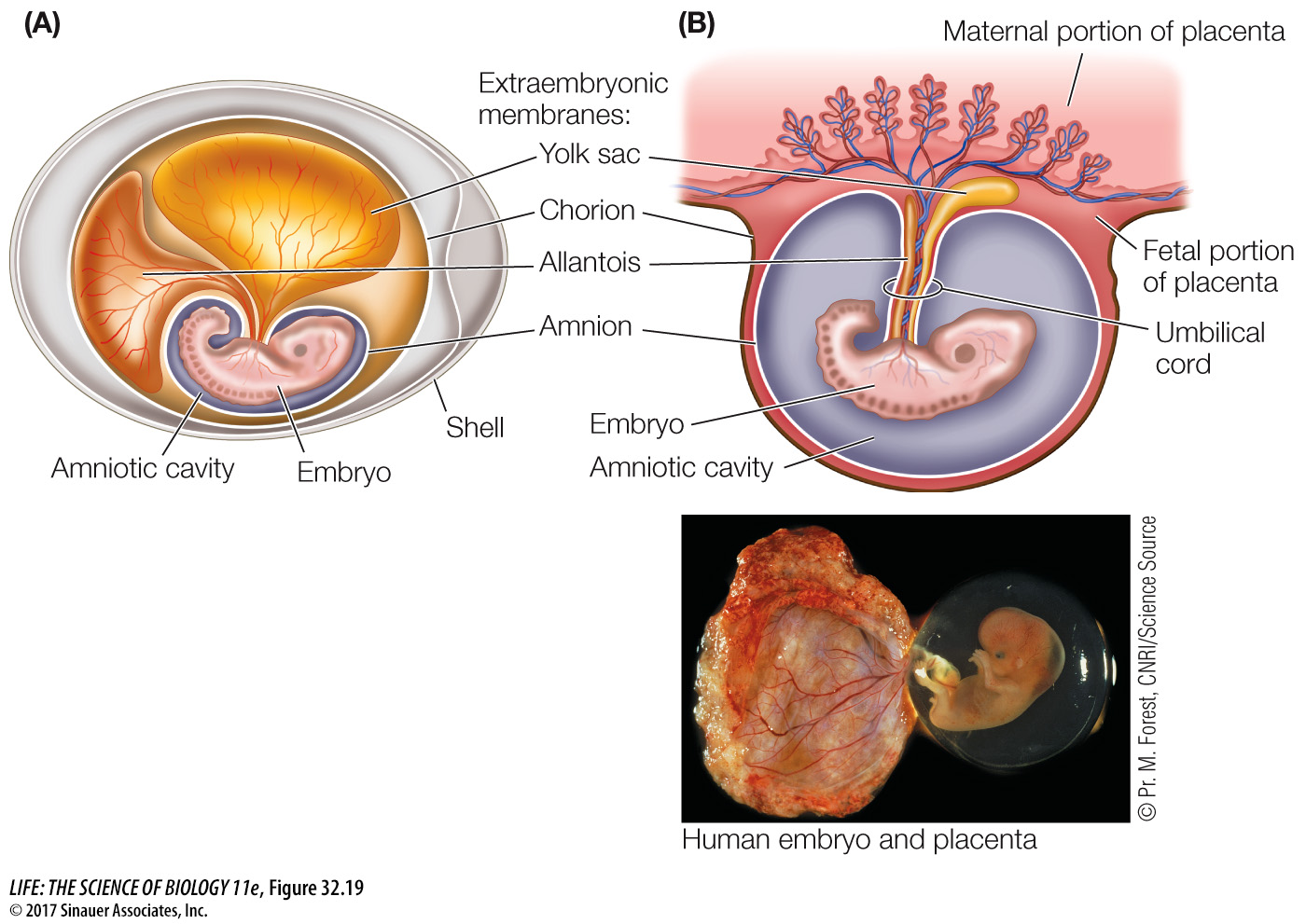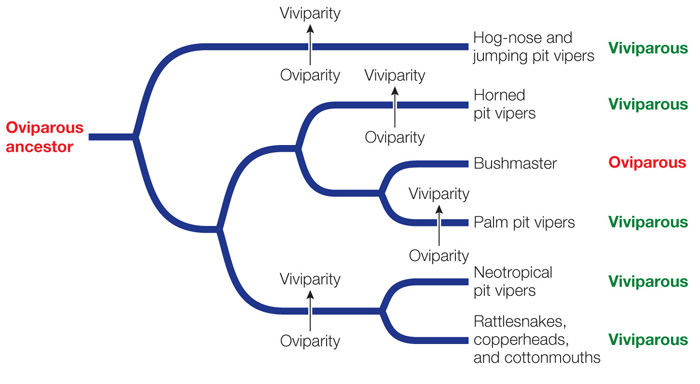Amniotes colonized dry environments
Several key innovations for conserving water contributed to the ability of the amniotes to exploit a wide range of terrestrial habitats. The amniote egg (which gives the group its name) is relatively impermeable to water and allows the embryo to develop in a contained aqueous environment (Focus: Key Figure 32.19A). Its leathery or brittle, calcium-
focus: key figure

Activity 32.2 The Amniote Egg
www.life11e.com/
Question
Q: How were the various membranes in the amniote egg modified in mammals to support viviparity?
In the amniote egg, nutrition is provided by the yolk sac, and the allantois functions in gas exchange and waste collection. The chorion holds all the various membranes together with the embryo, and also functions in gas exchange. The amnion provides structural support for the developing embryo. In viviparous species, the placenta provides nutrition, as well as gas and waste exchange, through the maternal circulatory system via the umbilical cord. Note that the yolk sac and allantois are involved in the makeup of the umbilical cord (retaining their roles in nutrition, gas exchange, and waste exchange), and the amnion and chorion retain their functions of structural support.
As we described in the opening of this chapter, modifications of the amniote egg in several different groups of amniotes allowed the embryo to develop inside (and exchange nutrients and wastes with) its mother’s body (Focus: Key Figure 32.19B). For example, in most mammals the egg lost its shell entirely while the functions of the extraembryonic membranes were retained and expanded, giving rise to viviparity. Viviparity appears to have evolved many times among lizards and snakes. In Investigating Life: Have Shelled Eggs Re-Evolved among Viviparous Reptile Lineages?, we explore the possibility that shelled eggs could have re-
699
investigating life
Have Shelled Eggs Re-
experiment
Original Papers: Pyron, R. A. and F. T. Burbrink. 2014. Early origin of viviparity and multiple reversions to oviparity in squamate reptiles. Ecological Letters 17: 13–
Wright, A. M., K. M. Lyons, M. C. Brandley and D. M. Hillis. 2015. Which came first: The lizard or the egg? Robustness in phylogenetic reconstruction of ancestral states. Journal of Experimental Zoology (Molecular and Developmental Evolution) 324B: 504–
The shelled amniote egg is a complex structure, and the transition from oviparity to viviparity requires extensive changes in reproductive morphology and physiology. For example, oviparous species have uterine shell glands that secrete calcium for eggshell construction. These shell glands are modified in viviparous species to provide calcium to the developing embryo. Viviparity is thought to have evolved from oviparity more than 100 times among lizards and snakes, but biologists wondered if the process can be reversed: does egg laying ever re-

work with the data
Original Paper: Fenwick, A. M., H. W. Greene and C. L. Parkinson. 2012. The serpent and the egg: Unidirectional evolution of reproductive mode in vipers? Journal of Zoological Systematics and Evolutionary Research 50: 59–
The tree below shows a small portion of the phylogeny and reproductive data collected for squamates, from the New World pit vipers. Use this data sample to answer the questions.

QUESTIONS
Question 1
Starting with a root state of oviparity, plot the minimum number of changes between oviparity and viviparity (in either direction) that is necessary to explain the distribution of reproductive states on the tree. What is the minimum number of changes required on this tree? Does that number include any reversals to oviparity?

The minimum number of changes is two, one of which is a reversal from viviparity to oviparity.
Question 2
Assume that the only changes that can occur are changes from oviparity to viviparity (do not allow any changes in the opposite direction). How many additional transitions in reproductive mode are necessary under this assumption compared with the result you obtained in Question 1?

Four changes from oviparity to viviparity are required, or two additional transitions in reproductive mode compared with the answer to Question 1.
A similar work with the data exercise may be assigned in LaunchPad.
Other innovations evolved in the organs of terrestrial adults. A tough, impermeable skin, covered with scales or modifications of scales such as hair and feathers, greatly reduced water loss. Adaptations of the kidneys (the vertebrate excretory organs), allowed amniotes to excrete concentrated urine, ridding the body of nitrogenous wastes without losing a large amount of water in the process (see Chapter 51).
During the Carboniferous, the amniotes split into two major groups: the reptiles and the lineage that eventually led to the mammals (Figure 32.20).
